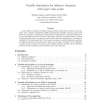Free Online Productivity Tools
i2Speak
i2Symbol
i2OCR
iTex2Img
iWeb2Print
iWeb2Shot
i2Type
iPdf2Split
iPdf2Merge
i2Bopomofo
i2Arabic
i2Style
i2Image
i2PDF
iLatex2Rtf
Sci2ools
IJAR
2010
2010
Variable elimination for influence diagrams with super value nodes
In the original formulation of influence diagrams (IDs), each model contained exactly one utility node. Tatman and Shachter (1990), introduced the possibility of having super-value nodes that represent a combination of their parents' utility functions. They also proposed an arc reversal algorithm for IDs with super-value nodes, which has two shortcomings: it requires dividing potentials when reversing arcs, and it tends to introduce redundant (i.e., unnecessary) variables in the resulting policies. In this paper we propose a variable-elimination algorithm for influence diagrams with super-value nodes that in general introduces fewer redundant variables, is faster, requires less memory, may simplify sensitivity analysis, and can speed-up inference in IDs containing canonical models, such as the noisy OR. Contents
| Added | 05 Mar 2011 |
| Updated | 05 Mar 2011 |
| Type | Journal |
| Year | 2010 |
| Where | IJAR |
| Authors | Manuel Luque, Francisco Javier Díez |
Comments (0)

